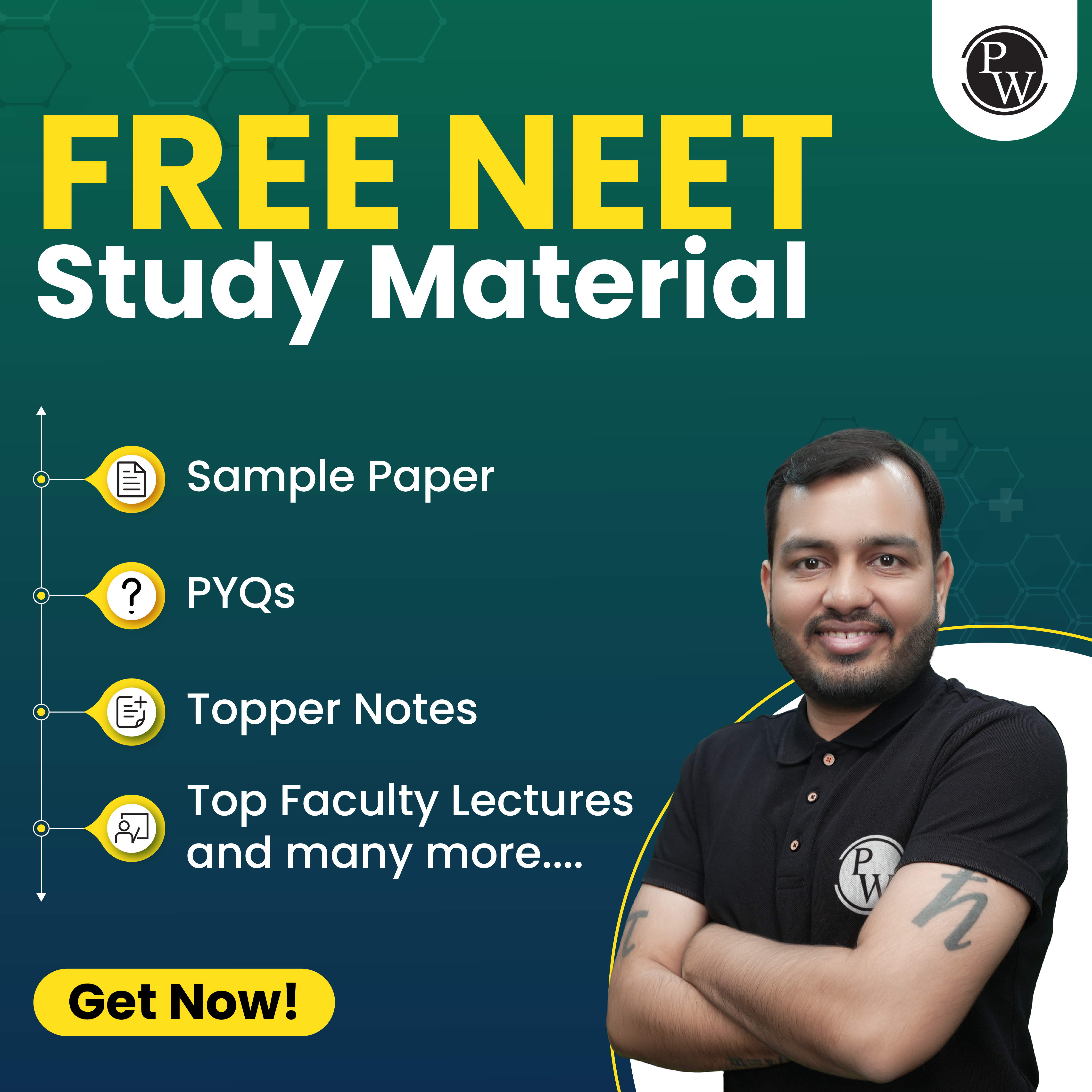
Plant Kingdom NEET MCQ: The plant kingdom comprises eukaryotic, autotrophic, photosynthetic, and non-motile creatures. According to R.H. Whittaker's classification of the plant kingdom in 1969, there are five main plant groups: Algae, Bryophytes, Pteridophytes, Gymnosperms, and Angiosperms.
The primary features of the plant kingdom include- The cellulose cell wall is present.
- except for certain aquatic species, non-motile.
- Reproduction is mostly sexual in nature.
- Different forms of algae (green, brown, and red algae), bryophytes, gymnosperms, and angiosperms are examples of organisms that survive by photosynthesis.
Also Check:
Plant Kingdom NEET MCQ
The plant kingdom is a major topic in the NCERT syllabus for the NEET examination and has a weightage of 18%. The topic is vast and requires dedicated hours of learning. In this article, we will go through some common Multiple-choice questions related to the NEET examination. Plant Kingdom NEET MCQ is a set of multiple-choice questions designed for NEET exam preparation. Focusing on plant-related topics like classification, morphology, and reproduction, it helps students to master essential botanical concepts. Plant Kingdom NEET MCQ facilitates targeted practice, ensuring a thorough understanding of plant biology, a key component of the NEET examination syllabus.NEET Study Material, Free Sample Papers, Book, Toppers Notes, PYQs
Plant Kingdom NEET MCQ with Solution
Plant Kingdom NEET MCQ with Solutions is helpful material for students preparing for the NEET exam. It contains questions about plants, covering topics like how they're classified, what they look like, and how they reproduce. Knowing about plants is important for NEET because there are questions about them in the biology part of the exam. This resource not only tests what you know but also gives you the answers so you can learn from your mistakes. It's a great way to practice and get ready for the NEET exam, making sure you understand the different aspects of plants that might be asked in the Exam.| NEET Exam Important Links | |
|---|---|
| NEET Syllabus | NEET Biology Notes |
| NEET Eligibility Criteria | NEET Exam Pattern |
| NEET Previous Year Question Papers | NEET Biology Syllabus |
Plant Kingdom NEET MCQ
Q 1. Which one of the following is false?
- Gametophytes are multicellular, tiny, and photosynthetic thallus.
- Pro-thallus is another name for sporophyte.
- Gametophyte is the predominant phase in mosses.
- Strobili, a distinctive cone-like structure, is present in Equisetum and Selaginella.
Answer: Option(2) is correct.
Explanation: Small and multicellular, the gametophyte is a photosynthetic thallus. Pro-thallus is another name for the gametophyte. Gametophyte is the predominant phase of mosses. The strobili are distinctive cone-like structures seen in Equisetum and Selaginella.
Prothallus is the gametophyte of several pteridophyte species, including ferns. Both male and female plant gametophytes are known to be produced by the prothallium, also known as the prothallus. It's crucial to comprehend what the prothallus is and how it is structured in order to comprehend its function.Q 2. Which of the below statements is false?
- Pteridophytes reproduce by spores, following the cryptogamic principle,
- Sporophytes are the primary plant body in pteridophytes,
- Pteridophytes thrive in arid and chilly environments, such as mountains,
- Pteridophytes contain specialized vascular tissues.
Answer: Option(3) is correct.
Explanation: Pteridophytes proliferate by spores like cryptogamae. Sporophyte is the primary plant structure of Pteridophytes. Pteridophytes can grow on sandy soils and occasionally in wet, shaded areas. There are specialized vascular tissues in pteridophytes.
The vascular free-sporing plants known as pteridophytes (ferns and lycophytes) have alternating, free-living gametophyte and sporophyte stages that, when they reach maturity, are independent of one another. The roots, stem, and leaves of the sporophyte are clearly distinct parts of its body. The root system is adventitious.Q 3. Which of the phrases regarding bryophytes below is false?
- Bryophytes stop soil erosion,
- They break down rocks to create rich soil,
- They are utilized as fuel and as packing materials,
- Food packaging materials are made of bryophytes since they don't absorb water.
Answer: Option(4) is correct.
Explanation: In order to stop soil erosion, bryophytes securely grip the soil. Bryophytes transform barren rocks into productive soil by breaking them down. Bryophytes are useful fuel sources and packaging materials. Bryophytes can't be utilized to store food since they are good water absorbers.
Q 4. What distinguishes liverworts from mosses in particular?
- Mosses have vascular tissue that liverworts lack.
- In contrast to liverworts, mosses have an intermediate stage known as protonema.
- Mosses grow taller, whilst liverworts do not.
- Sporophytes, specialized bodies found only in mosses, are missing in liverworts.
Answer: Option(2) is correct.
Explanation: Mosses develop into a stage known as protonema from spores before developing into thallus, which resembles leaves. In contrast, this transitional stage is not present in liverworts, therefore the spores grow into a thallus without a protonema.
Mosses are tiny, flowerless plants that belong to the Bryophyta category, along with liverworts and hornworts. They lack xylem and phloem-like circulatory systems and primarily absorb water and nutrients through their leaves. They often grow in bunches or mats on the forest floor in moist, shaded areas. They often only reach a height of 10 cm, although the unusual species Dawsonia may reach heights of 50 cm.Q 5. What statement regarding the haplontic life cycle is incorrect?
- The predominant stage of its life cycle is the gametophyte stage.
- Sporophytes live independently.
- Spores are haploid in nature, and they divide during mitosis to generate gametophytes.
- Zygote functions as a sporophyte.
Answer: Option(1) is correct.
Explanation: Gametophytes are the predominant stage in this life cycle, which is why the answer is (a). Sporophytes cannot live a life of their own free will. Spores are naturally haploid and develop into gametophytes during mitotic division. A zygote produces spores in the role of a sporophyte.

Q 6. Which one of the following is false?
- The majority of leafy liverworts share structural similarities with mosses,
- Liverworts have oil bodies that moss lacks,
- Moses have lobes in their leaves but leafy liverworts lack,
- Mosses have spirally organized leaves whereas leafy liverworts have leaves that develop in two or three rows.
Answer: Option(3) is correct.
Explanation: The majority of leafy liverworts have a structure that is similar to mosses. Oil bodies are present in leafy liverworts but not in mosses. Mosses lack lobes in their leaves, but leafy liverworts do. While the leaves of mosses are organized in spirals, those of leafy liverworts grow in two or three rows.
Q 7. Which statement concerning the haplo-diplontic life cycle is false?
- In this life cycle, the sporophytic and gametophytic phases both have the same length of time.
- The sporophytic and gametophytic stages are both multicellular and exist separately.
- Pteridophytes and bryophytes both have this form of life cycle.
- The life cycle of Ectocarpus is haploid.
Answer: Option(4) is correct.
Explanation: Both the sporophytic and gametophytic phases in this life cycle have several cells and their own autonomous existence. The primary periods of this life cycle vary. Bryophytes and Pteridophytes both have this type of life cycle. The haplo-diplontic and not haploid life cycle is seen in Ectocarpus.
Q 8. Which one of the following is false?
- The haploid gametophyte is the predominant phase in bryophytes.
- The main phase in Volvox is the haploid gametophyte.
- In Spirogyra, the dominant phase is the diploid sporophyte.
- In Pappaya, the dominant phase is the haploid gametophyte.
Answer: Option(3) is correct.
Explanation: In bryophytes and volvox, the haploid gametophyte phase predominates. Additionally, the haploid gametophyte is the dominant phase in Spirogyra. The haploid gametophyte is the predominant phase in Pappaya.
Q 9. Which of the following life cycles does Polysiphonia exhibit?
- Diplontic,
- Haplontic,
- Trilontic,
- Haplo-diplontic.
Answer: Option(2) is correct.
Explanation: The majority of algae are haplontic, whereas just a small percentage are diplontic. A handful of these algae, such as Polysiphonia, Ectocarpus, and kelps, have haplontic life cycles, in which the gametophyte phase dominates.
The term "haplontic life cycle" describes the stage of an organism's life cycle that is controlled by a single pair of chromosomes, also known as the haplontic stage. Algae displays the haplontic life cycle. Algae and plants demonstrate alternation in the generation. They alternate between the diplontic sporophytic stage and the haplontic gametophytic stage as they reproduce sexually.Q 10. Which of the following statements concerning the diplontic life cycle is false?
- Sporophyte is the dominant phase,
- All spermatophytes have a diplontic life cycle,
- Sporophytes and gametophytes are mutually dependent,
- Sporophyte feeds on the gametophyte.
Answer: Option(3) is correct.
Explanation: Sporophyte is the dominating phase. The life cycle of all spermatophytes is diplontic. Sporophyte is necessary for Gametophyte. Because sporophytes can do photosynthesis and have autonomous existence, they can also make their own nourishment.
Q 11. Which of the below statements is false?
- Male and female gametes develop in sexual organs called gametophytes,
- Male gametes are delivered to female gametes by means of water,
- Male and female gametes further fuse to produce a zygotic structure that develops into an embryo,
- This embryo continues to grow to form a haploidic structure known as sporophytes that bear spores.
Answer: Option(1) is correct.
Explanation: Gametes are created in sex organs known as gametangia. Gametophyte is the life cycle of sexual reproduction. It takes water for the male gametes to reach the female gametes. In order to create a zygotic structure, which eventually becomes an embryo, male and female gametes must fuse further. A haploid structure known as a sporophyte that bears spores grows from this embryo throughout time.
Q 12. Which of the following statements is false?
- Male and female gametes fuse to generate zygotes, which are diploid in nature.
- After zygotes undergo reduction division, sporophytes are formed.
- The sporophyte goes through meiosis to create spores.
- Spores sprout to create a new thallus.
Answer: Option(2) is correct.
Explanation: Zygote, which is diploid in nature, is created by the union of male and female gametes. After fusing, the zygote does not immediately proceed into reduction division. Instead, they develop a structure known as a sporophyte. To create spores, the sporophyte goes through meiosis. As they germinate, spores produce new thallus.
Q 13. What stage of a liverwort's life cycle is the most prevalent?
- Diploid sporophyte
- Diploid zygote
- Haploid gametophyte
- Diploid spores
Answer: Option (3) is correct.
Explanation: The haploid gametophyte stage of the liverwort's life cycle is the most prevalent. Gametophyte is the end product of the short-lived intermediate structures called diploid sporophyte, diploid zygote, and diploid spores.
Q 14. Which of the following statements concerning gymnosperm reproduction is false?
- Microsporangium contains microsporocytes that go through meiosis to become microspores,
- Microspores then go through reduction division to create microgametophytes,
- Microgametophytes are also known as pollen grains,
- Wind, water, and insects function as dispersion agents for pollination.
Answer: Option(1) is correct.
Explanation: Microsporocytes seen in microsporangia go through mitosis and not meiosis to become microspores. Microspores then divide by reduction to become microgametophytes. The term "microgametophyte" also refers to pollen grain. As dispersion agents for pollination, wind, water, and insects all play a role.
Q 15. Which of the following statements regarding gymnosperms is false?
- Pollen grains produce a tube-like structure when they reach the female gametophyte, which carries sperm to the egg.
- Gymnosperm fertilization is also known as siphonogamic.
- Unlike angiosperm ovules, Gymnosperm ovules are not protected.
- Every megaspore that is created after meiosis undergoes mitosis to form a female gametophyte.
Answer: Option(4) is correct.
Explanation: The pollen grains create a tube-like structure that acts as a conduit for sperm to get to the egg when they contact the female gametophyte.
Gymnosperms also have a siphonogamic mode of fertilization. In contrast to angiosperms, gymnosperm ovaries are not protected. One of the four megaspores that are produced following meiosis is functional, while the other three degenerate. PW NEET online coaching offers aspirants a comprehensive learning experience, bringing NEET preparation to your fingertips. With expert faculty, interactive classes, and personalized study plans, it ensures effective exam preparedness. Accessible anytime, anywhere, it maximizes convenience, providing aspirants with a tailored approach to success in the challenging NEET examination.Plant Kingdom NEET MCQ FAQs
What are the plant kingdoms in NEET?
What is the plant kingdom class 11?
How to learn the plant kingdom?










